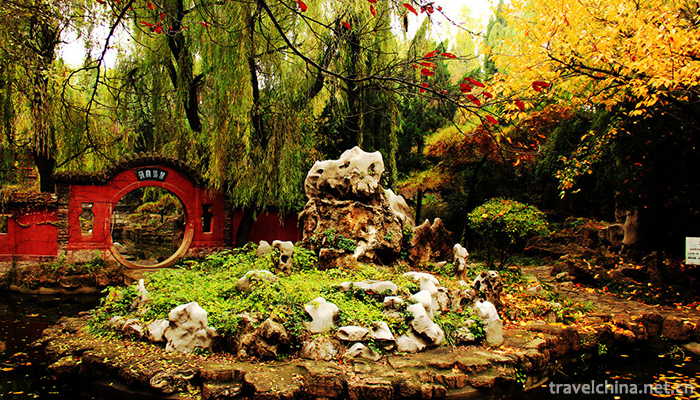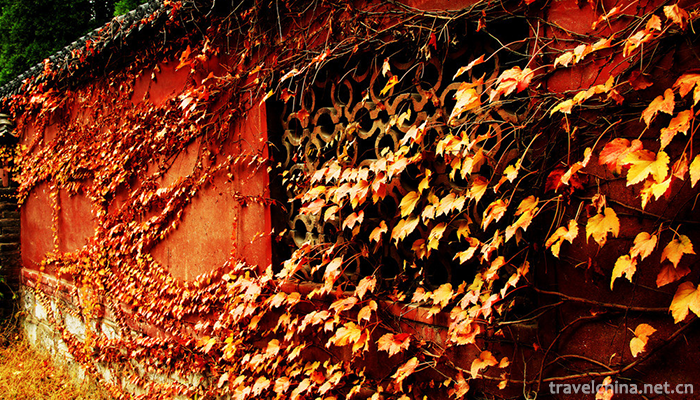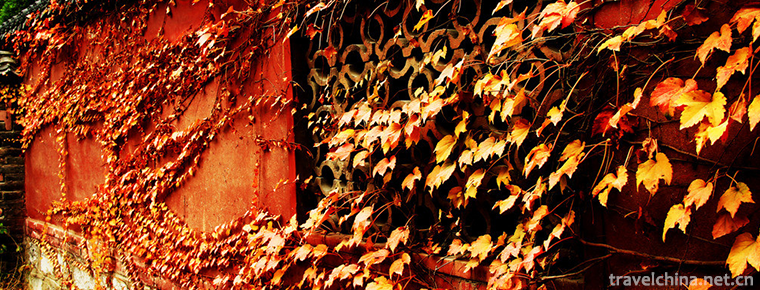Liao Zhai City
Liao Zhai City
Liaozhai City was invested and built by Pujiazhuang, Zichuan. It is a large-scale famous garden scenic area with gardens as its manifestation and Liaozhai stories as its theme. It is located in Pujiazhuang, Hongshan Town, Zichuan District, Zibo City. This is the birthplace of Pu Songling, the king of short stories in the world. It belongs to the national AAAA tourist attraction and one of the five major tourist attractions in Shandong Province.
Pu Weng's descendants set up Zibo Liaozhai Tourism Development Co., Ltd. to meet the development requirements of the tourism market. They take the promotion of Pu culture as their duty, and constantly intensify the development of Liaozhai cultural tourism resources. They have formed tourist attractions such as Liuquan, Liaozhai Palace, Fox Immortal Garden, Shiyin Garden, Manjing Temple, Liqu Tea House and Cemetery, which have made the construction of Liaozhai City take shape.
Introduction
Liaozhai City is a large garden-style scenic spot developed and constructed by Pujiazhuang villagers on the basis of Liuquan and Pusongling Tombs. It is the first batch of national AAA tourist scenic spots, Jiangbei folk custom tourist attractions and famous tourist attractions in Shandong Province. The main attractions are:
Fox fairy garden is a classical gardening building in the north. The landscape of Lotus pond, rockery, stele gallery and pavilion are different in the garden. There are well-carved poems by Mr. Wang Yuyang and Mr. Pu Songling in the stele gallery.
Shi Yin Garden was originally Bi's Garden in Xipu Village. Mr. Pu Songling set up a library to teach at that time. He wrote a lot of excellent poems and lyrics about the scenery of Shi Yin Garden and many famous works of Liao Zhai. There are Wanku Mountain, Yuanxin Pavilion, Xia Qixuan, Zhangrenshi, Tongchuntang and other landscapes built in the park.
Liuquan is located at the bottom of the Donggou of Pujiazhuang Village, formerly known as a well full of wells, which often overflow. Also because of the planting of willows around, there are willows and springs, also known as willow springs. At that time, it was the main road between Qingzhou Prefecture and Jinan Prefecture, with bustling passers-by. Legend has it that Pu Songling used to set up tea and smoke in Maoting Pavilion near the spring. Every time passers-by passed by, he was invited to rest. He was asked to talk about foxes and ghosts so as to collect materials and create Strange Tales from Liaozhai. Pu Songling liked Liuquan very much. He named himself "Liuquan Jushi" and carved a Liuquan seal. In his inscription "Preface to the Raising and Building of the Dragon King's Temple", he called the spring "water is clear, sweet and fragrant, wine is brewed, and incense is added, and it is not easy to give Penglai". Today's Willow Spring, although there is no spring that springs out of the day, but the Maoting Pavilion is just like, weeping willows Yiyi, still vaguely visible in that year's scenic spot. A new "Liuquan" stele, written by Mr. Shen Yanbing, has been erected beside the spring. It has become the main scenic spot in the garden, and visitors are bound to visit it.
Pu's cemetery is located in the east of Pujiazhuang village, covering an area of 5 mu. There are more than 30 ancient tombs and more than 30 ancient cypress plants. In the northwest corner of the cemetery, Pu Songling's tomb is a joint Tomb of his wife, Liu Ruren. There is a monument building in front of the tomb. The tomb table of Mr. Liu Quanpu written by Zhang Zhi, a famous scholar of the Qing Dynasty, has nine characters in front of the tomb written by Shen Yanbing's relative book "The Tomb of Mr. Pu Songling and Liu Quan". There are also the tombs of Pu Songling's father, Pu Pan, and his eldest grandson, Pu Lide, and the tablets of Pu Luhun and Pu Zhang, the governors of Banyang Road, which were replaced by Pu's distant ancestors.
Liaozhai slang teahouse is a place for visitors to enjoy tea, rest, enjoy Liaozhai slang, watch Liaozhai feature films, rest and entertainment.
Liaozhai Palace is the main scenic spot in Liaozhai City, covering an area of 31 mu, 33 meters high, with a building area of 2000 square meters. Built with Bihu, Qingshan, Quqiao, fountain, archway, Pavilion and other scenic spots, the palace uses modern color sculpture, using high-tech techniques to reproduce the story of Strange Tales from Liaozhai.
Manjing Temple was rebuilt on the original site, covering an area of 15 mu, with a construction area of 1068 square meters. The temple takes the double arch arch archway as the entrance gate. It is built with the Temple of Heavenly King, the Palace of Daxiong, the Three Saints Hall, the Bell Tower, the Vegetarian Chamber and the Health Care Place, as well as two Zen Pagodas and more than 100 Buddhas.
The Qinyuan of the eunuch was built in October 2002. It covers an area of 12 Mu and has a construction area of 600 square meters. It is located in the west of Liaozhai Palace. The theme is Qin, Yuan and Qing. It has four scenic spots, namely, Daoism, Xueqin, Yuanyuan and Qintai. In addition, the scenic area also hosts annual international Liaozhai Cultural and Art Festival, Liaozhai Cultural and Art Works Exposition, Liaozhai Slang Competition and Liaozhai Folk Tales Speech Competition. Liaozhai Folk Art Lantern Festival and other activities have made the scenic spots seek novelty in the process of change and specialty in the new China, attracting more than 600,000 tourists annually. In the same year, Liaozhai Performing Arts Plaza, which accommodates 15,000 people, was built. Different performances show the folklore and local conditions vividly and vividly, with unique charm.
The Pu Songling Memorial Hall in the tourist attraction of Liaozhai City preserves the original appearance of Pu Songling's residence. The former residence is a typical northern rural courtyard. Guo Moruo's inscription of "Pu Songling's former residence" has a gold-lettered plaque hanging over the gate of the former residence. Inside the courtyard are Pu Weng's Liao Zhai, Pu Weng's life exhibition room, Pu Wenshi exhibition hall, which Pu Wen loved for ten years, and the calligraphy and painting exhibition hall of contemporary literati and poets. Liuquan, also known as Manjing, set up a place for Pu Weng to collect tea. There is a stone tablet of "Liuquan" inscribed by Shen Yanbing. The spring mouths built with blue stones overflow with water, which makes tourists linger and forget to return. Pu Songling has created thousands of slang works besides Strange Tales from a Liaozhai Studio. The slang teahouse is the best place to sing and watch slang. Tourists stop to taste tea and listen to some slang songs, which is a rare enjoyment. Fox fairy garden is designed and constructed with Liaozhai stories as the main body. It has exhibition rooms for Pu Songling's life and works, Pu's career in paving the museum, celebrities'calligraphy and painting, etc. Shiyin Garden is originally Bi's Garden. The Taraxacum has set up Bifu Hall for 30 years. It has written a lot of excellent poems and lyrics about Shiyin Garden. The garden is lined with strange stones and shaded by green trees. This garden moved to Pu Weng's hometown, reproducing the life experience of the dandelion tongue plowing and brushing. Manjing Temple is rebuilt as an ancient temple, with double arch arch archway as the entrance gate. There are Tianwang Hall, Daxiong Palace, Three Saints Hall, Bell Tower and other buildings. Liaozhai Palace looks like Qionglou across the sky, green lakes and mountains, such as the Heavenly Palace Queen. By means of color sculpture, film stunts and light vocal music, the artistic image of the devil, ghost and fox in Pu Weng's works is artistically reproduced.
The whole Liaozhai city covers an area of 1000 mu and invests 160 million yuan. Now it has formed Jiangbei cultural garden which embodies the characteristics of Pu culture and Liaozhai culture. Walking around Liaozhai City, avoiding the noise of downtown city, fully reflects the world of fox ghosts and Demons depicted by Pu Songling, a literary hero.
Strange Tales from a strange studio
Liaozhai Zhiyi, a collection of short stories of the Qing Dynasty, is Pu Songling's representative work, which was basically completed when he was about 40 years old, and has been constantly updated and revised since then. "Liaozhai" is the name of his library, "Zhi" is the meaning of description, and "weird" refers to strange stories. There are 491 short stories in the book. The subject matter is very extensive and the content is extremely rich. By talking about foxes and ghosts, most of the works strongly criticized the corruption and darkness of the society at that time, exposed social contradictions to a certain extent, and expressed the wishes of the people. But there are also some feudal ethics and fatalism of karma. The artistic achievement of Strange Tales from Liaozhai is very high. It succeeded in shaping many artistic models, vivid characters, bizarre plots, rigorous and ingenious structure, concise writing, delicate description, can be called the peak of Chinese classical short stories.
It is said that Pu Songling, the author of this book, opened a teahouse at his door and invited tea drinkers to tell him stories. After that, he would not pay for tea. After listening, he would revise and write it into the book.
Liaozhai Zhiyi is a collection of short stories in classical Chinese. There are legends, fantasies, anecdotes and so on. They have all kinds of styles. They are the masterpieces of Chinese classical novels. The content is very extensive. It talks about foxes, demons, flowers and demons in order to summarize the social relations at that time and reflect the social outlook of China in the 17th century. The book is about a world of demons, ghosts and foxes, which is not only dissatisfied with the dark social reality, but also unfair with the rare talent and difficult official career. It is about the whipping of corrupt officials and the praise of civilians who are brave in resisting and revenging. The most beautiful and moving people are those with foxes and demons, people and ghosts, as well as people and people. Chapter of pure love between people.
Tourism information
Tourism activities
1. Liaozhai Folk Art Lantern Festival (8th to 18th January);
2. Liaozhai Cultural Tourism Festival (April 29-May 8);
3. Liaozhai Cultural and Art Expo (September 28-October 8);
4. International Liaozhai Cultural Tourism Festival in Zibo, China (1-7 May each year)
Characteristic landscape
Liaozhai Palace, Fox Fairy Garden and Shiyin Garden.
Opening Hours
Summer: 7:30-18:00; Winter: 8:00-17:00
Recommended line
Pu Songling Art Museum - Fox Fairy Garden - Shiyin Garden - Liuquan Villa - Eunuch Maid - Eunuch Maid - Qinyuan - Liaozhai Palace - Peony Garden - Liqu Teahouse - Baizi Playground - Manjing Temple - Liuquan - Liuquan Ancient Road
Traffic information
Distance from the airport: 80 km from the airport: 90 minutes by car;
The distance from the railway station is about 22 kilometers, and the distance from the railway station is about 30 minutes.
The distance from the bus station is about 5 kilometers and the distance from the bus station is about 10 minutes.
200 km from Qingdao Wharf
3 km from Zichuan Railway Station
Self driving:
1. Jiaowang Road-Lutai Culture Road-Songling East Road-Liaozhai Section of Hunan Road-Scenic Spot under Zichuan Intersection of Binbo Expressway.
2. Zhangdian along Zhangbo Road to Zichuan-Songling East Road-Liaozhai Section of Hunan Road-scenic spot.
Bus: You can take No. 1 bus from Zibo Bus Station to Zichuan Station and transfer to No. 23 Short-distance bus and get off at Pujiazhuang.
Fare information
Pu Songling's former residence is 40 yuan per person
Ticket description: College students, the elderly (over 60 years old), especially needy workers and servicemen hold valid certificates of 20 yuan per person; primary and secondary school students visit certificates of 10 yuan per person.
80 yuan per person in Liaozhai City
Tickets for scenic spots can be purchased with bank card.



-
1.Gold medal suckling pig
Roasted Suckling Pig. Characteristic: It has won the "Golden Ding Award" by the national commercial department. It is a precious Cantonese dish at the banquet.
Time 2018-11-14 -
2.Tengchong Volcanic Hot Sea Tourist Area
The volcanic hot sea is located 20 kilometers southwest of Tengchong County. It covers an area of 9 square kilometers. There are more than 80 large gas springs and hot springs. Among them
Time 2018-12-12 -
3.Spinach with Eight Delicacies
Babao spinach is a traditional Shandong dish, which belongs to Shandong cuisine. It is rich in color, bright, delicious, light and refreshing. In addition to spinach, Babao spinach is also equipped wi
Time 2019-03-25 -
4.Three Old People of Korean Nationality
Three Koreans are the traditional folk opera form of the Korean nationality in China. It is composed of three actors who perform in the role of the elderly and merge the forms of Korean opera singing
Time 2019-04-16 -
5.Making Skill of Roe Skin of Oroqen Nationality
The Oroqen nationality is one of the minorities with the smallest population in Northeast China. Because of the influence of living environment and customs, people of the Oroqen nationality
Time 2019-04-28 -
6.Hexi treasure roll
Hexi Baojuan, a traditional folk literature in Liangzhou District of Wuwei City and Suzhou District of Jiuquan City, Gansu Province, is one of the national intangible cultural heritages.
Time 2019-05-03 -
7.Huian stone carving
Hui'an stone sculpture mainly served religion in its early stage, with strong religious color. It is mainly embodied in the architectural design, sculpture and installation of the temple,
Time 2019-05-05 -
8.Aquatic horsetail embroidery
Horsetail embroidery is a special embroidery technique inherited from generation to generation by Chinese aquarium women, which is the oldest and most national characteristic. It takes horse tail as a
Time 2019-06-16 -
9.Yandi Festival
"Yandi Mausoleum Festival" is divided into official and folk sacrifices. Folk sacrifice began in summer, official sacrifice originated in Zhou, and Emperor sacrifice originated in Tang Dynas
Time 2019-07-10 -
10.Orthographic drama
Zhengzi opera, originally known as Zhengyin opera, is singing in Zhongzhou Mandarin. It is an ancient and rare opera with many voices. In the early Ming Dynasty, one of the Southern Opera was introduc
Time 2019-07-25 -
11.Cao Xueqin
Cao Xueqin (about May 28, 1715 - February 12, 1763) Name Stained with Word Dream Ruan No. Xue Qin No. 2, Qin Xi and celery, Chinese classic. The Dream of Red Mansion The author of the book is controve
Time 2019-09-07 -
12.Daheishan Forest Park
Daheishan Forest Park is located in Wuben Township, Renhe District, Panzhihua City, Sichuan Province. From the center of Panzhihua bingcaogang River Panshan 58 kilometers, through Guaziping, Lanjian mine and Wuben township.
Time 2020-10-15